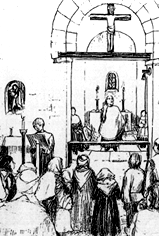Meet the Middle Ages
BackThe medieval service

The church service was a mystery and a drama to medieval people. Here, they met God and Heaven.
"In nomini Patris et Filii et Spiritus Sancti. Amen"(In the name of the Father, the Son and the Holy Spirit. Amen). This was the beginning of the medieval service. Much of what the priest said was in Latin. People learned to recognise certain words and expressions. It may not have been very important to the parishioners to understand everything - the important thing may have been to see and to feel. The fragrance of incense and the wax candles created a very special atmosphere. At some point, the priest turned towards the congregation and said: "Dominus vobiscum" (May the Lord be with you) and the people answered: "Et cum spiritu tuo" (and with your Spirit). The most important part of the service was Holy Communion. When the priest held up the bread and said "Hoc est corpus meum" (This is my body), a special little bell, a "primklocka", rang. The same bell was rung when the priest poured the wine. Everyone could see what happened. The bread and the wine were transformed into the body and blood of Christ.
There were no benches inside the church. People were glad to be able to walk around a little, especially if it was cold inside the church. During the winter there might have been fires, braziers with burning coal, inside the church, so that people could keep warm.
The priest delivered a sermon only on special occasions, on certain days when saints were celebrated, or at Easter and Christmas.
The sermon was delivered in the native language, in Swedish in Sweden, in Danish in Denmark and so on. It was always short. The service on an ordinary Sunday lasted perhaps 40-45 minutes, on a feast day maybe a little longer. In addition to Sunday Mass, the priest said the daily prayers at the canonical hours. Usually, not many people attended these short prayer services.